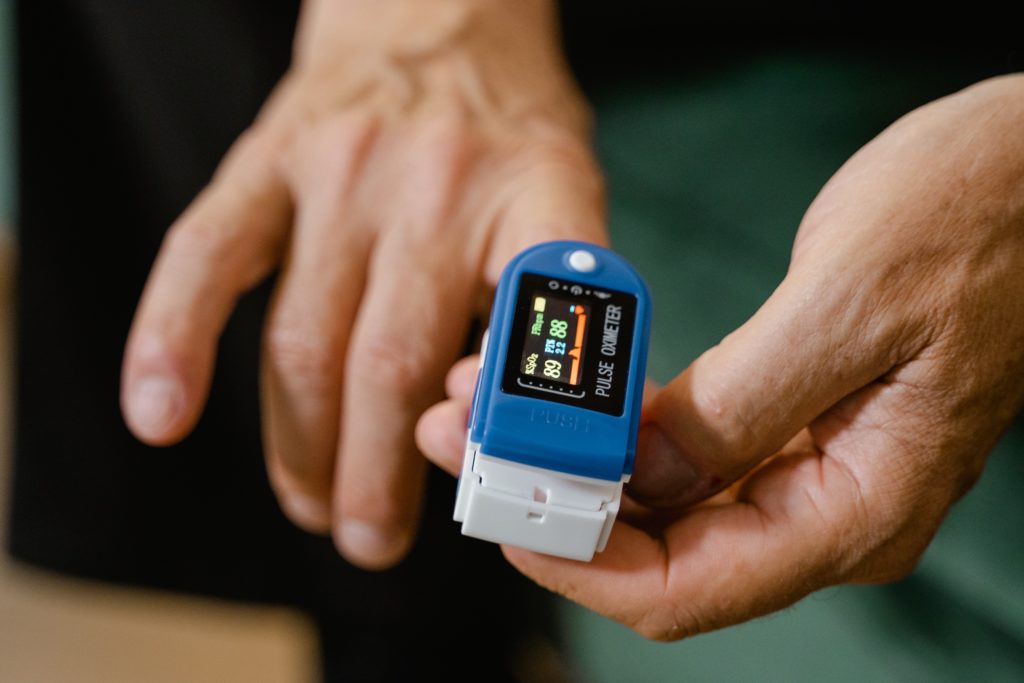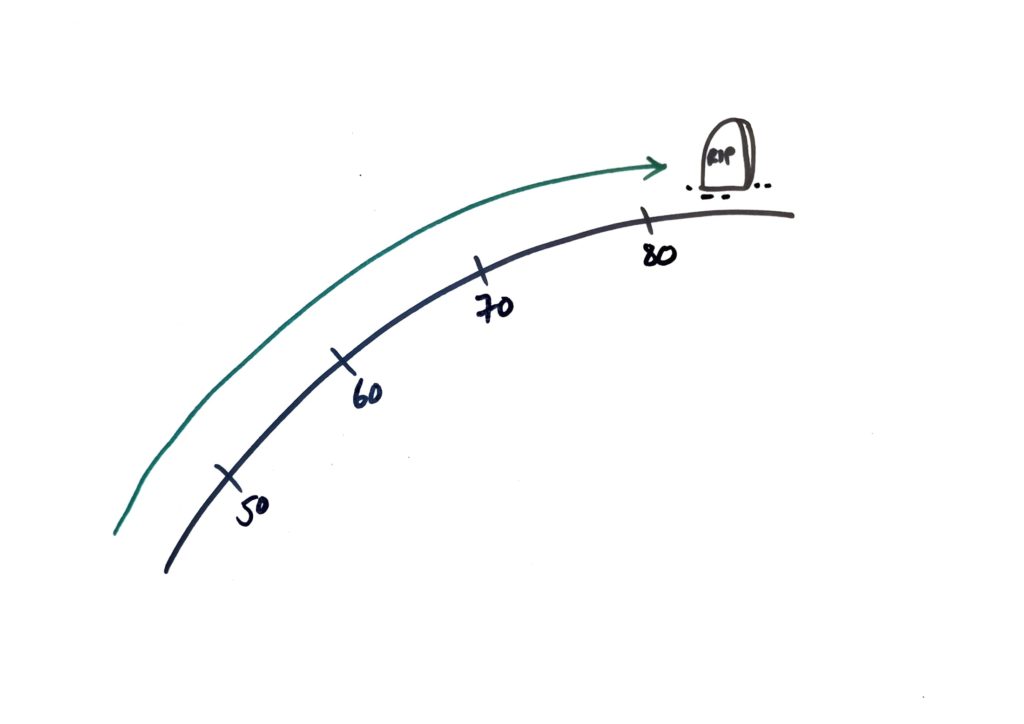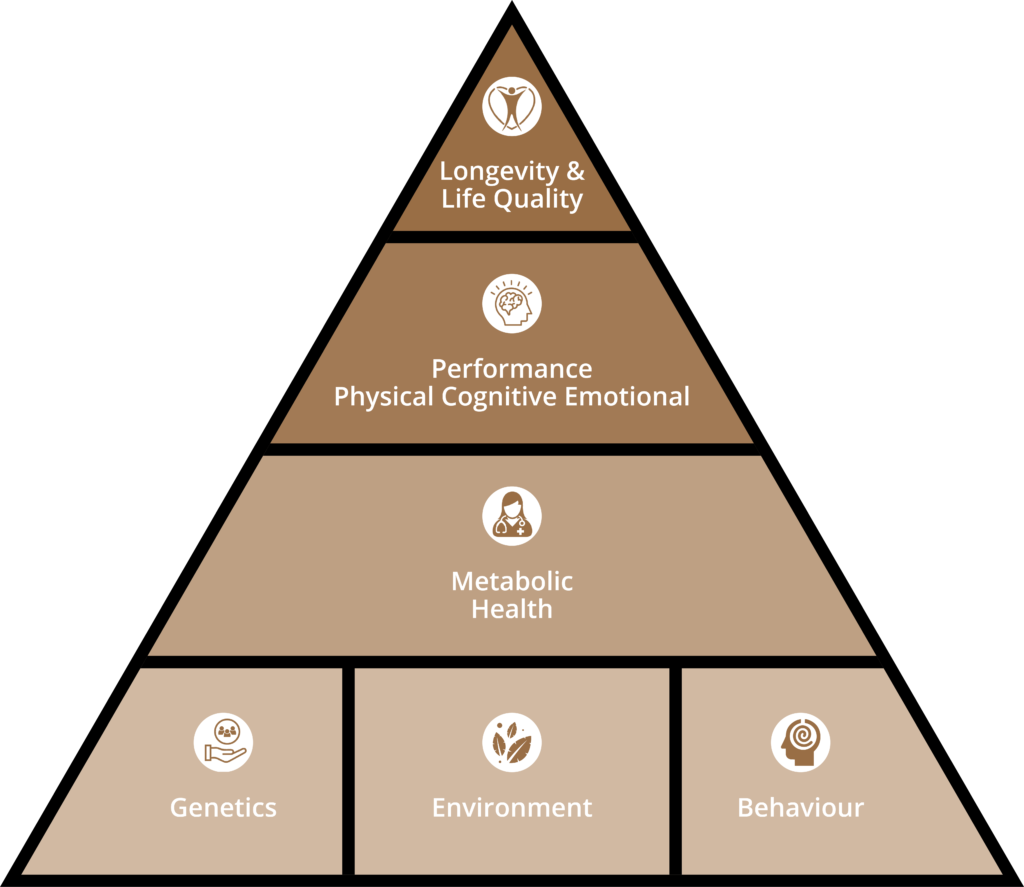
When you started working you undoubtedly got wise advice to plan for your future retirement. Acting on this advice you would have met a financial advisor. This expert would have assessed your current situation, helped you determine your future goals and then created a plan that will allow you to achieve those goals.
With that plan set, you then commit to spending the next 40-50 years investing towards that goal. The plan may change over time, but there is always awareness and commitment to achieving the future retirement you want.
However, to have the lifestyle you want takes more than just your finances. Health is the linchpin of your retirement plans.
Health is the key
Securing the lifestyle you want in retirement will almost certainly require a financial investment. However, failing to invest in your health will undermine your efforts to achieve that future.
There are two reasons why. The first is obvious. Without having good health in your retirement years you will not have the physical, cognitive or emotional ability to do what you want when you want.
No one imagines a future where they spend most of the time in an armchair, regularly visiting the doctor and pharmacy, taking handfuls of medication every day, using a zimmer frame to move about, wearing an incontinence pad “just in case”, and relying on carers or family to help with things like getting washed and dressed.

The second reason is that maintaining good health during your working years allows you to continue to financially invest towards your retirement.
If your health declines then you risk not being able to work up to or, if needed, past your retirement age.
This could be because you are no longer able to perform physically, cognitively or emotional at a high enough level needed for your work. You may develop a chronic disease that makes working too difficult to maintain. There are also associated healthcare costs that come with poor health. Either way, this will impact your retirement finances.
Without investing in your health you are not actively trying to prevent this from occurring.
Failing to plan is planning to fail
Unlike finances, most people do not seek proactive health planning advice. They do not comprehensively assess their current health or specify their future health and performance goals. There is no personalised plan. There is no consistent action taken over decades.
Often there is no awareness of the importance of health or it is taken for granted… until something goes wrong.
As a doctor, this is something I see all too often. I recall an appointment I had with a patient who had just turned 60. He was coming up for a planned early retirement and was going to celebrate with a month-long holiday abroad. His wife had insisted that he get a health check beforehand, for peace of mind.
During the appointment, he reported that he had started to notice that he was becoming very short of breath on walking upstairs.

He had no prior health problems and wasn’t on any regular medication. However, he was overweight, exercised little and drank a little too much alcohol.
On further examination and investigation, it was found that he was in fact diabetic and had suffered a silent heart attack at some stage.
This changed everything for my patient. His plans for retirement had to change as he felt he was no longer physically capable of doing the things he wanted to do.
He had multiple doctor appointments to attend and had to adjust to taking several medications every day. He no longer felt safe travelling abroad just in case his health deteriorated further.
A longer, but not healthier, life
Unfortunately, our modern healthcare services are failing to prevent the onset of diseases such as heart disease, diabetes, strokes and dementia. In fact, the number of people living with these non-communicable diseases (NCDs), also called diseases of lifestyle, is increasing.
Healthcare services are fantastic at managing acute health problems such as trauma and infections. When it comes to NCDs, their focus is more on enabling the patient to live longer with the disease rather than preventing it.
In the UK, this can be seen with the latest ONS data on lifespan and health span.
Lifespan, also known as life expectancy, is the number of years you are expected to live on average. This number has been increasing with every generation. A 45-year-old man today is expected to live until 84 years of age [1].

Healthspan, also known as healthy life expectancy, is the number of years you are expected to live free from disease or disability. Unlike lifespan, healthspan is falling with every generation.
Currently, men will live 62.4 years before they are diagnosed with an NCD. About 55% of all men between the ages of 60-65 will have at least one NCD [2]. Surveys show that soon after the age of 65 our personal well-being (life satisfaction, how worthwhile life is, and happiness) starts to decline [3].
This means that men will spend a fifth of their life living with impaired health and quality of life.
It was sad to see the plans and dreams of my patient ruined. But what was sadder still was that this could have potentially been avoided. NCDs, like his heart attack and diabetes, are diseases of lifestyle. It is thought that 80% of cases could be avoided through optimising lifestyle factors such as diet, exercise, sleep and stress [4].
How to plan for your future health
By approaching your future health as you would your future finances, you can significantly increase your chances to secure a longer, healthier life of high performance and quality.
So, like financial planning, there are several steps involved in creating an effective health plan:
- Establish your goals
- Collect information about the foundations of your health
- Analyse your current health and performance status
- Develop the health plan needed to achieve your goals
- Implement the health plan
- Review progress

1. What are your health and performance goals?
The first step is to get an accurate picture of what you want your future to look like. This can be difficult as you will need to consider the physical, cognitive and emotional requirements for activities that you currently do every day without a second thought.
You may want to be able to run 5km, surf, race a go-kart, learn a new language, rebuild a car engine, complete the crossword, carry shopping in from the car, walk up several flights of stairs, or just be able to hold a conversation whilst walking with friends or family.
At this stage, try not to be influenced by your assumptions about ageing. By going through this process of creating and consistently investing in your health plan, you are removing yourself from what the “average” ageing population can expect.
In fact, studies have found that if you expect physical decline then you are more likely to experience that decline as you age [9]. So try to have positive expectations. This will help you make better choices to maintain your health and performance later in life.
2. Collect information about the foundations of your health
Once you have your goals, you need to build towards them from a solid foundation. So it is important to understand your “foundational triad of health”, i.e. your genetics, your environment and your behaviours. These are the bedrocks on which your health and performance are built.

Your genetics can tell you what your potential future health risks are and how you respond to inputs such as nutrition and exercise. DNA tests are a popular way of gathering this information.
Perhaps a more powerful way to determine those risks and responses is by taking a detailed family history. Knowing what health problems run in your family will highlight exactly what your potential health risks could be.
Assessing how your environment influences your health is not just about the obvious hazards such as pollution, toxins and infections. It is also about how the physical world in which you live limits or enhances healthy behaviours.
For example, you may have to commute for hours a day or sit at a desk all day, minimising your non-exercise physical activity. You may work outside all day, exposing yourself to excessive sunlight. The job you do may be highly pressured causing chronic stress or requiring long hours which limits your social connections.
Being aware of these environmental factors will help you to develop strategies to minimise their impact on your health now and in the future.
The third part of the triad, and probably the most influential of the three, is your behaviour. This is all about the habits and routines that you do every day. This includes your physical activity, exercise, food choices, hydration practices, sleep routines, stress management, social interactions, relationships and many others.

By understanding the prompts, motivation, difficulty and rewards of your habits and routines, you can manipulate them. By tweaking any one of these four components you can change existing habits or add new ones to benefit your health and performance.
3. Analyse your current health and performance
The next step is to analyse your current health and performance. The journey to developing many of the NCDs usually starts with a metabolic disorder such as insulin resistance. Blood tests provide key insights into your metabolic health.
Although the choice of tests should be based on your assessment of your “foundational triad” and future goals, the absolute minimum needed would be testing your insulin sensitivity, glucose control, lipids (including apoB and lp(a)), and inflammation.
For a more complete picture, it may be worthwhile checking your hormones (testosterone and thyroid for example), vitamins and minerals, electrolytes, renal function, liver function and a full blood count.
Unlike modern healthcare services, don’t always accept having test results in the normal range as being good enough. Normal is not optimal. For example, vitamin B12 is important for the health of your nervous system. It has a normal range from 130 to 950 pg/ml but the optimal range is around 400-500 pg/ml.
To analyse your performance there are a variety of tests that can be done. Most commonly this would include your blood pressure, resting pulse rate and rhythm, body mass index, and waist circumference.

There are many other biometric measurements you could monitor but it is best to choose those tests that match your goals. For example, if you want to be able to pick up any future grandchild when you’re older then you may want to measure your maximum strength in key resistance exercises such as the leg squat and shoulder press.
No matter your goals, I would suggest you should regularly measure your aerobic fitness (also known as cardiorespiratory fitness). This performance metric is a powerful predictor of your healthspan [5]. Having low cardiorespiratory fitness is associated with an increased risk of developing NCDs.
There are a variety of ways to measure your aerobic fitness. Some require specialist equipment and some just need a stopwatch. A couple of options you can do at home are the 12-minute run test (also known as the Cooper test) or the 6-minute walk test if you are unable to run for 12 minutes. The distance you cover during the test is used to calculate your aerobic fitness (measured as VO2max).
4. Develop your health plan to achieve your goals
Now that you know your goals, your foundations and your current health, a personalised, precise and proactive plan can be created to set you on the path to achieving those goals.
To ensure that you are optimising your health and maximising your performance as you age, your plan must include the key lifestyle factors of nutrition, physical activity, sleep and stress management. Depending on what you discovered during the previous two steps, you may also need to consider adding supplements or medication as part of that plan.

Nutrition
When it comes to your nutrition there is no one diet that suits all. There is low carb, low fat, high protein, low calorie, ketogenic, plant-based, paleo, Mediterranean and many more. The choice depends on your preferences, your response to the food and your current health. For example, if you are prediabetic or diabetic it may be better to go on a low carb or ketogenic diet initially.
Physical activity
Physical activity doesn’t just mean planned exercises such as aerobic training and strength training. It also means the non-exercise movement that you do during the day. These are activities such as walking the dog, cleaning the house, standing up, and playing with your kids or grandchildren.
Your plan should include strategies to maximise both your exercise and non-exercise physical activity. For example, if mainly desk-bound, then plan for regular stand-up and move breaks throughout your working day. Another example would be taking the stairs instead of the escalator. These activities can have more impact on your metabolism than exercise, so it is important to consider this.
Sleep
Getting consistent, sufficient and high-quality sleep is essential for good physical, cognitive and emotional health. Therefore it must be considered in your planning.
This doesn’t just include setting a bedtime and wake time to get you the recommended 7 hours of sleep. It means creating routines and habits that help make it highly restorative.

For example, developing a sleep routine that has you avoid blue screen time an hour or so before bed, or not eating within 3-4 hours of bedtime, improves the quality of your sleep and disrupts your circadian rhythm.
To really maximise your sleep, also include routines on waking, such as getting early sunlight exposure or the timing of exercise, as this can influence your quality of sleep later on.
Stress
Stress is inescapable and any health investment plan must include tactics and techniques to manage it. Stress triggers the release of a hormone called cortisol. If there is a prolonged release, which occurs with chronic stress, then this negatively impacts your metabolic health.
By optimising your nutrition, exercise and sleep you can significantly help counter this, but by doing activities specifically to help relax you. By doing activities like tai-chi, yoga, meditation, or breathing exercises you can induce a rest and digest response to counter the stress.
Plan for the inevitable
Unfortunately, despite your best efforts, there are changes that occur with ageing that are unavoidable. Your bones get weaker, your fat mass goes up, your skin gets wrinkly, your heart will pump blood less effectively, and your hearing gets worse for example.
To minimise the impact of these age-related changes, your plan will have to take this into account.
For example, after the age of 50, there is about a 10-15% loss of strength per decade. After the age of 70, this increases to 25-40% loss [6]! The same occurs for aerobic fitness. There is a 15% decline in VO2max per decade after the age of 50 [7].

So if you are wanting to be able to lift a 20kg suitcase off the baggage claim when you are 70 years old, then you will need to have the strength to lift double that at the age of 50.
Of course, this is very simplistic but it demonstrates the point. Your physical, cognitive and emotional performance will decline with age. Ensure a high standard for your older self by developing a plan that maximises your current health and performance. That way any losses you experience will not stop you from achieving your future goals.
5. Implement the plan
No matter how detailed, comprehensive and wonderful your plan is, it is completely useless if it is not acted on. However, if taking action was easy then we would be a lot healthier and happier.
We all know that regular exercise is good for our health yet 1 in 3 adults do meet aerobic exercise recommendations. Worse still only 1 in 20 meet both the aerobic and strength training recommendations [8].
We generally know what to do to benefit our health, and we want to do it. But actually doing it seems to be a step too far for many of us.
A good way to increase the likelihood of taking action is to find someone with similar goals to pair up with. For example, you could become training buddies and exercise together.
This helps to keep you motivated, increases your chance of success, creates accountability and commitment, provides support and makes it more enjoyable.

Another way to help you establish healthy habits and behaviours is to start small. Make it easy to do so that motivation is not needed.
For example, you want to establish a habit of jogging for 30 minutes every day. Start small with a 5 minute walk or whatever you feel is so easy to do that it would not require any motivation to do.
Once you are doing this consistently, you can start to slowly build up the pace or the time or both. As long as it doesn’t start to feel difficult to do and needs motivation to get it done. Eventually, over time, you will build the habit of jogging for 30 minutes every day.
The key thing to remember is that it isn’t a sprint (unless that’s one of your training sessions!) when it comes to health. So take your time in building up the habits and behaviours that will last a lifetime.
6. Review progress
The final part of any plan is to monitor and review your progress. This ensures that adjustments can be made if something is not effective or if your goals change.
When it comes to your health and performance it can be difficult to say how often you should be reviewing your progress.
For example, waiting 3 months before measuring how your body composition has changed is too long.
However, for maximum strength, having a review every 3 months would be appropriate.
When designing your health plan, you should set appropriate review checkpoints depending on your goals.

The key lifestyle behaviours like nutrition, exercise and sleep, could be monitored daily.
Performance metrics like aerobic fitness, maximum strength, cognition tests and emotional performance surveys, could be reviewed every 3 months.
For metabolic health tracking, blood tests can be done every 6 months.
As the saying goes, what is measured is managed. Make sure you choose metrics that help guide you towards achieving your goals.
Key takeaway
We are living for longer but nearly a fifth of our time will be spent suffering with poor health and performance.
Having seen a repeating pattern of patients being diagnosed with NCDs and having their future plans derailed, it was clear to see that our current approach to healthcare must change.
These diseases of lifestyle are preventable if we plan and invest in our health as we do our finances.
So, get advice, set your goals, understand your current situation, create a plan, implement that plan and review your progress regularly.
This will give you the greatest chance of achieving the future you want.
References
- Life expectancy calculator – Office for National Statistics
- Health state life expectancies, UK: 2018 to 2020
- Living longer: how our population is changing and why it matters
- Noncommunicable diseases
- Importance of Assessing Cardiorespiratory Fitness in Clinical Practice: A Case for Fitness as a Clinical Vital Sign: A Scientific Statement From the American Heart Association
- Ageing accounts for much of the association between decreasing grip strength and subsequent loneliness: the English Longitudinal Study of Ageing | Journal of Epidemiology & Community Health
- The Effect of Aging on Relationships between Lean Body Mass and VO2max in Rowers
- Who is meeting the strengthening physical activity guidelines by definition: A cross-sectional study of 253 423 English adults? | PLOS ONE
- Expectations Regarding Aging, Physical Activity, and Physical Function in Older Adults




